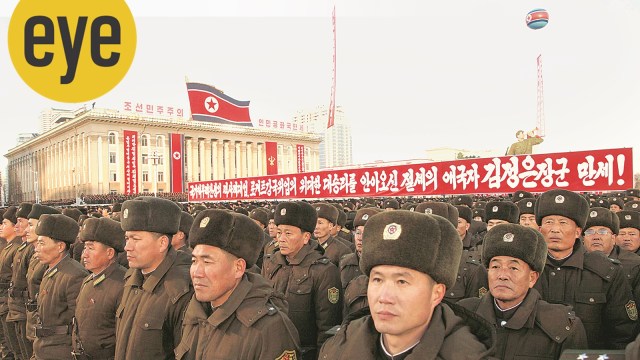In Autocrats, former diplomat Rajiv Dogra looks at what makes autocratic regimes rise and fall
The author has studied the lives and methods of Nicolae Ceausescu, Stalin, Hitler, Xi Jinping, Vladimir Putin, Mussolini, Mao Zedong, Kim Jong II, François Duvalier, Idi Amin and many others, drawing conclusions about how they seized and retained power for long.
 A 2017 military parade in Pyongyang, North Korea commemorating a missile test (PTI)
A 2017 military parade in Pyongyang, North Korea commemorating a missile test (PTI)For some years, I have been interested in the genesis, evolution, decline and fall of dictators and autocrats. My interest was kindled initially by George Orwell’s Animal Farm (1945). It was fascinating to read the story of the main protagonist, Napoleon, who overthrew his erstwhile ally, Snowball, deluded working-class animals with his lies and tyranny, all with the support of Squealer, a white pig who served as his second-in-command and minister of propaganda. I read The Light on Faraway Hill by JR Packard, a similar story of rats overcoming mice and an owl taking control. I have read several such books, and the one that stands out in my memory is How to be a Dictator (2019) by Frank Dikötter.
Former ambassador Rajiv Dogra’s new book, Autocrats: Charisma, Power and Their Lives (Rs 795, Rupa), is probably the most comprehensive one I have read in this genre. As Dogra has described himself while introducing another one of his books, he is “an engineer by training, a diplomat by profession, a writer by choice”. He is also an “artist, a television commentator and a newspaper columnist.” Dogra has a rare talent and a remarkable facility with words, making each of his six books easy reading. Another characteristic of his writing is deep and meticulous research. He has studied the lives and methods of Nicolae Ceausescu, Stalin, Hitler, Xi Jinping, Vladimir Putin, Mussolini, Mao Zedong, Kim Jong II, François Duvalier, Idi Amin and many others, drawing conclusions regarding how they seized and retained power for long.
The book is divided into seven parts, starting with the genesis of autocracy and ending with its downfall. He talks of how autocracy develops gradually to full-blown dictatorship. The methods used by the autocrat, the pattern of autocratic rule, the gradual separation of the autocrat from reality and the end, where people’s admiration turns to hatred and scorn, and the revival of democracy, are described in detail. He also talks about the “soft side of autocracy” — the eating habits of autocrats, the peculiarities of their wives and their family lives. In the last part, he talks of the horrific ends that some of them meet.
Dogra says democracy alone does not guarantee that the elected leader will not arrogate power to himself. “But why do the otherwise democratic countries stray towards authoritarianism?” he asks. “A possible explanation is that they do so because institutional safeguards, meant to check just such trends, begin to crumble.” Besides, the weaknesses inherent in democracy, feeble leadership, fear of losing elections, disunity in the leadership, inability to make timely decisions and a sluggish bureaucracy create deep discontent, which makes people look for a strongman who will usher in a new age of prosperity and happiness. People begin to feel, as Plato wrote many centuries ago, “What we need is a benevolent dictator.” Indeed, the present moment in history is conducive to forming autocracies. As Biden said in 2021, “We’re at an inflexion point between those who argue that autocracy is the best way forward… and those who understand that democracy is essential.”
 Rajiv Dogra’s new book, Autocrats: Charisma, Power and Their Lives (Amazon.in)
Rajiv Dogra’s new book, Autocrats: Charisma, Power and Their Lives (Amazon.in)
The man with autocratic tendencies rides to power on a groundswell of popular opinion. Such people have some common traits — they are generally narcissistic, lying comes easily to them; they have the capacity to weave dreams and project them convincingly, create hatred and divisions in society, and speak with authority in a manner that resonates with the people. As the ancient Greek writer Euripides puts it, “When one with honeyed words but evil mind persuades the mob, great woes befall the state.”
Having acquired power, the dictator knows how to preserve and strengthen it. He consolidates his rule through force and fear. He is prone to impulsive action. As he believes in his intuitive powers and the conviction that he can do no wrong, some of these actions prove detrimental to the people. Still, he is often given the benefit of the doubt, particularly in the early stages. He surrounds himself with yes-men and ensures that the bureaucracy speaks his language. He keeps people on their toes with sudden policy changes and imaginative follow-ups. He and his henchmen ensure that they control most of the mainstream media space: “Like God, he must observe you from everywhere.” He constructs magnificent edifices designed to project his greatness. He spends time on how to present himself before the public and launches massive and expensive publicity programmes to enhance his image further. He endeavours also to garner plaudits from foreign leaders.
Some changes take place initially, which seem to be positive. Trains run on time; officials reach their offices at the stipulated time. But, over time, he creates a dream world divorced from reality. He does not want to understand the genuine problems that people face. He takes dissent as personal hostility and endeavours to crush it with all the might, all the investigative and regulatory agencies at his disposal. As the writer puts it, “By one estimate, the yearly GDP growth is inflated in most authoritarian regimes by a factor of 1.15 to 1.35.”
Broadly speaking, countries led by autocrats have disappointing economic outcomes as compared to democracies. And it is not just on economic growth that dictators fail to deliver. They also fall short on employment, health and education spending, and government debt.
Then comes disillusionment and the ultimate fall. He fails to read the writing on the wall. Rebellions similar to the Arab Spring and the more recent events in Sri Lanka and Bangladesh may happen, generally spearheaded by students and workers. The forces on which the autocrat depends say, “Thus far and no more,” and the autocrat is left to fend for himself. The end can be tragic, as in the case of Ceausescu, Saddam Hussein and Muammar Gaddafi, or the erstwhile dictator may only retire into oblivion.
All in all, this is a great book written by a highly skilled writer.
The writer is former cabinet secretary and author of As Good as My Word: A Memoir
Photos


- 01
- 02
- 03
- 04
- 05





























